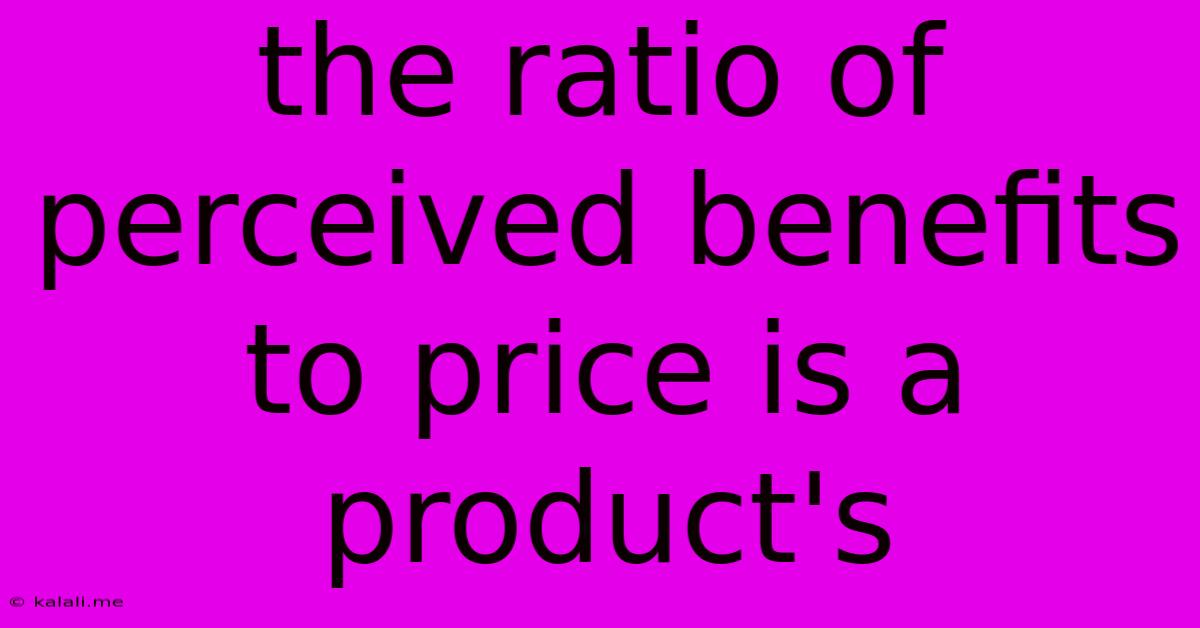The Ratio Of Perceived Benefits To Price Is A Product's
Kalali
Jun 14, 2025 · 3 min read

Table of Contents
The Ratio of Perceived Benefits to Price: A Product's Value Proposition
The success of any product hinges on a simple, yet powerful equation: the ratio of perceived benefits to price. This isn't just about the monetary cost; it's about the entire value exchange between the consumer and the brand. Understanding and optimizing this ratio is crucial for building a strong value proposition and achieving sustainable market success. This article delves into the intricacies of this ratio, exploring its components and offering strategies for maximizing its impact.
What exactly is "perceived benefit"? It's not just about the product's features. While features are undeniably important, perceived benefit encompasses the emotional, psychological, and functional advantages a customer anticipates from owning and using the product. This includes things like:
- Problem-solving: How effectively does the product address a customer's pain point?
- Convenience: Does it simplify tasks or improve efficiency?
- Status: Does it enhance the customer's social standing or self-image?
- Pleasure: Does it provide enjoyment or entertainment?
- Quality: Does it offer durability, reliability, and performance?
- Exclusivity: Is it unique or limited edition, adding to its desirability?
The Price Isn't Just a Number
The "price" component extends beyond the monetary cost. It incorporates:
- Monetary cost: The actual price tag.
- Transaction costs: Time and effort involved in purchasing the product (e.g., shipping fees, waiting time).
- Opportunity costs: The value of alternatives forgone by purchasing this product.
- Psychological costs: Any feelings of risk, uncertainty, or regret associated with the purchase.
Optimizing the Ratio: Strategies for Success
The goal is to maximize the perceived benefits while minimizing the perceived price. Here are some strategic approaches:
Enhancing Perceived Benefits:
- Highlighting Value-Added Services: Offer free shipping, warranties, excellent customer support, or exclusive access to content. These add to the overall value proposition without necessarily increasing the base price.
- Strategic Marketing & Branding: Craft a compelling narrative that emphasizes the product's unique benefits and emotional resonance. Use strong visuals, testimonials, and case studies to showcase its impact.
- Focus on Quality and Durability: Investing in high-quality materials and manufacturing processes translates into long-term value and customer satisfaction, boosting perceived benefit.
- Building a Strong Brand Reputation: A trusted brand commands higher perceived value, even if the price is slightly higher than competitors.
Managing Perceived Price:
- Strategic Pricing Strategies: Consider employing pricing tactics like value pricing (offering high value at a competitive price) or premium pricing (justifying a higher price through superior quality and features).
- Payment Options: Offering flexible payment plans can reduce the perceived financial burden and increase accessibility.
- Transparency and Communication: Clearly communicate the product's value proposition and justify the price with detailed information and explanations.
- Creating a Sense of Urgency or Scarcity: Limited-time offers or limited quantities can increase perceived value by creating a sense of urgency and exclusivity.
Analyzing the Competition
A crucial aspect of optimizing the perceived benefit-to-price ratio is understanding your competitors. Analyze their offerings, pricing strategies, and marketing messages to identify opportunities for differentiation and improvement. What are they doing well? Where are their weaknesses? Can you offer a superior value proposition at a competitive price point?
Conclusion:
The ratio of perceived benefits to price isn't merely a formula; it's a fundamental principle underpinning successful product development and marketing. By understanding its components and employing the strategies outlined above, businesses can create products that resonate with consumers, build strong brand loyalty, and ultimately achieve sustainable market success. Remember, it’s about delivering more than just a product; it’s about delivering an exceptional experience and justifying the investment for your customers.
Latest Posts
Latest Posts
-
Symptoms Of Too Much Exhaust Back Pressure
Jun 14, 2025
-
Deflection Of A Simply Supported Beam
Jun 14, 2025
-
Which Of The Following Is An Example Of A Variable
Jun 14, 2025
-
What Is 1 Watt Equal To
Jun 14, 2025
-
An Electric Current Is The Flow Of
Jun 14, 2025
Related Post
Thank you for visiting our website which covers about The Ratio Of Perceived Benefits To Price Is A Product's . We hope the information provided has been useful to you. Feel free to contact us if you have any questions or need further assistance. See you next time and don't miss to bookmark.